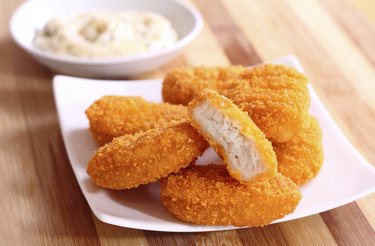
Ever since Michael Pollan's book "The Omnivore's Dilemma" hit the shelves, the safety of the preservative tertiary butylhydroquinone, or TBHQ, has been an object of contention. A common ingredient in Chicken McNuggets and other preserved foods, it is not harmful at the levels that are permitted in foods; the FDA's limits on TBHQ in food prevent ill effects and toxicity.
Uses
Video of the Day
TBHQ is a synthetic antioxidant that is used to extend the shelf life of oily and fatty foods. In processed foods, it's sprayed on the food or on its packaging to prevent discoloration and changes to flavor and odor. Others products, such as cosmetics, perfumes, varnishes and lacquers, contain TBHQ to maintain stability.
Video of the Day
Butyl
Much of the hype surrounding TBHQ dwells on its relationship to butane, a component of lighter fluid. Pollan called TBHQ a form of butane in his popular book, but it turns out the relationship is overstated. TBHQ is composed in part of a grouping of four carbon atoms, called a "butyl." Many harmless substances, such as butter, also contain butyl. The word butyl is even derived from the Latin word for butter, "butyrum."
Toxicity
The FDA has imposed a limit of up to 0.02 percent of the total oils in food to be TBHQ. Consuming 1 g of TBHQ could cause you to experience symptoms ranging from nausea to collapse, while 5 g is a lethal dose. The FDA's limits mean that you'd have to eat more than 11 pounds of Chicken McNuggets to reach a dose of 1 gram of TBHQ -- and that would have to be in one meal, since it does not build up in the body over time.
Common Sense
Although TBHQ might be safe in small doses, that doesn't mean it's healthy for you. And since it's used to preserve processed foods that are naturally oily or fatty, avoiding these foods would certainly be a healthy choice. When considering your health, do a bit of research before deciding that the popular account is the correct one.